Table of Contents
- Introduction
- The Symbolism of Bluebirds
- Bluebirds and the Arrival of Spring
- Habitat and Behavior of Bluebirds
- Conservation Efforts for Bluebirds
- Conclusion
- FAQs
Introduction
Bluebirds are often regarded as one of nature’s most beautiful and uplifting symbols, particularly in the context of spring. Their vibrant blue plumage and cheerful songs make them a beloved sight in many regions. This article explores the significance of bluebirds as harbingers of spring, their habitat, behavior, and the importance of conservation efforts to protect these iconic birds.

The Symbolism of Bluebirds
Bluebirds have long been associated with happiness, hope, and renewal. In many cultures, they are seen as messengers of joy and positive change. Their appearance is often interpreted as a sign that brighter days are ahead, making them a fitting symbol for the spring season.
Bluebirds and the Arrival of Spring
In many regions, bluebirds are closely linked to the arrival of spring. As the snow melts and temperatures rise, bluebirds return from their winter migrations, signaling the start of a new season. Their presence is a reminder of nature’s cyclical renewal and the beauty of the changing seasons.
Habitat and Behavior of Bluebirds
Bluebirds are typically found in open woodlands, orchards, and gardens. They prefer areas with scattered trees and plenty of open space for foraging. These birds are known for their insectivorous diet, feeding on beetles, caterpillars, and other small insects. Bluebirds are also cavity nesters, often using tree hollows or specially designed nest boxes to raise their young.
Conservation Efforts for Bluebirds
Despite their symbolic importance, bluebirds have faced challenges due to habitat loss and competition for nesting sites. Conservation efforts, such as the installation of nest boxes and the preservation of natural habitats, have played a crucial role in supporting bluebird populations. These initiatives ensure that future generations can continue to enjoy the sight of bluebirds heralding the arrival of spring.
Conclusion
Bluebirds are more than just beautiful birds; they are powerful symbols of hope, renewal, and the arrival of spring. By understanding their behavior, habitat, and the importance of conservation, we can help protect these cherished creatures and the natural cycles they represent.
FAQs
1. Why are bluebirds associated with spring?
Bluebirds are associated with spring because they often return from their winter migrations as the season begins, symbolizing renewal and new beginnings.
2. What do bluebirds eat?
Bluebirds primarily feed on insects such as beetles, caterpillars, and grasshoppers, making them beneficial for natural pest control.
3. How can I attract bluebirds to my garden?
You can attract bluebirds by providing nest boxes, maintaining open spaces, and planting native shrubs and trees that offer food and shelter.
4. Are bluebirds endangered?
While some bluebird species have faced population declines due to habitat loss, conservation efforts have helped stabilize their numbers in many areas.
5. What is the significance of bluebirds in different cultures?
In many cultures, bluebirds symbolize happiness, hope, and positive change, often appearing in folklore and literature as messengers of good news.
